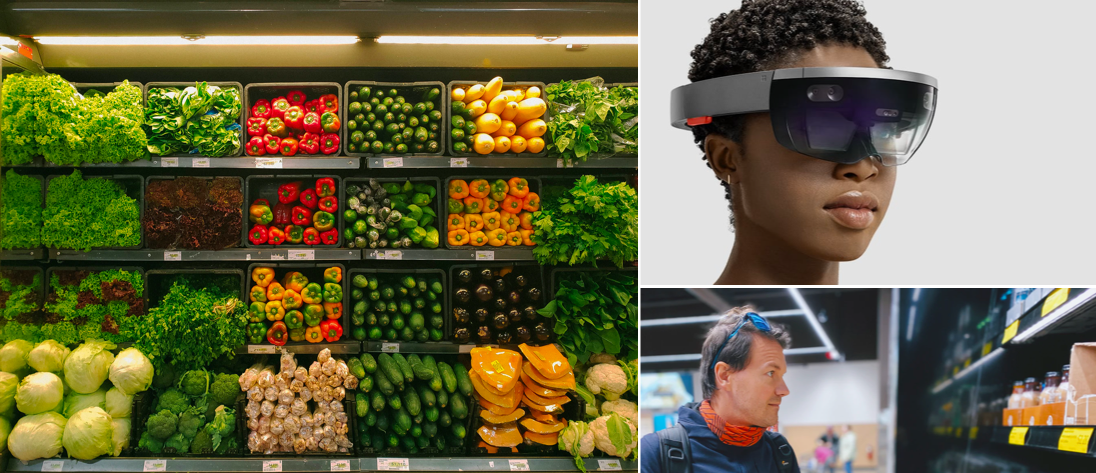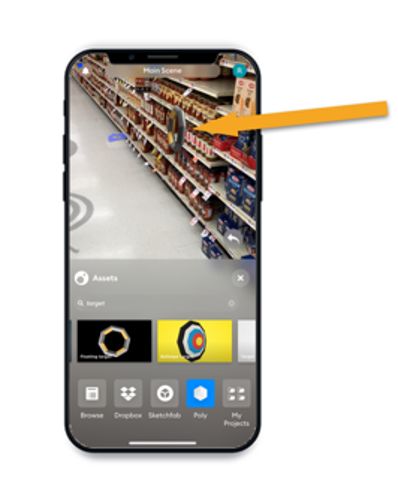
For my capstone research in my graduate program I examined the burgeoning area of augmented reality (AR) user interfaces with potential applications in industrial settings. I challenged myself to think outside of traditional GUI applications and to create prototypes myself.
Determine if there is a statistical difference in time to complete a wayfinding task between using AR tools and not using any augmentation.
I conducted a literature review as well as usability tests focused on wayfinding in a grocery store, which tested five conditions: no augmentation (control), haptic augmentation, visual augmentation, auditory augmentation, and multimodal augmentation (haptic, visual, and auditory). As part of my work, I analyzed the data I collected and reported on the results. I utilized what I learned to make recommendations for future directions in this space.

In the visual augmented reality condition, all of the participants exclusively looked through the phone and not at their surroundings. Instead of using it as an aid, they fully entrusted the device.
The majority of people preferred the auditory augmentation (3 participants). Participants felt as though it gave the most concrete information. Even though it gave the same amount as the visual augmentation, participants seemed to find it easier to use. Perhaps this is because they encoded information in a similar way to what they do normally.
The haptic augmentation device seemed to help orient or cue people as to when they were in the general vicinity of the item but did not help people locate the item when close by. The initial cue of the first vibration was reported as helpful. The secondary vibrations that were almost constant were perceived as annoying or distracting.
The combination augmentation in which all three augmentations were used seemed to be overwhelming for most users. The various forms of stimulation in addition to the stimulation of the grocery store combined to increase the user’s mental load.
The usability tests sought to test whether there was a significant time difference between using an AR device and traditional unassisted methods to find an item. Reviewing the data from the five participants, there were no statistically significant differences at a standard alpha level (0.05). Visually, there appears to be a difference between the control condition (baseline) and AR devices as shown in Figure 3. None of the differences were statistically significant using paired t-tests.
Interestingly, the visual augmentation condition was seen as the least effective. The baseline was the second least effective, but not the lowest as predicted. Similar to the measurement of ease, there were no statistically significant differences between any of the experimental conditions and the control condition.
This project pushed me to work on my prototyping skills outside of traditional GUIs. New technology is always around the corner and I chose this project to showcase my ability to understand new technical capabilities and translate possible features in usable design recommendations.
I made a great effort to apply human factors best practices during my study. Participant safety was a top priority. I made sure to make all of the prototype devices as safe as possible. The haptic prototype was the most worrisome in this regard, but given my budget and timeline, I did the best I could to avoid danger. I also followed best practices in my experimental design. I counterbalanced the order that participants were exposed to the AR prototypes. A balance of gender was achieved, a usability protocol was created and followed, and my data analysis followed statistical reporting guidelines.
There were some limitations to my project. In the data collection process, I used a convenience sample, which resulted in a young average age amongst participants. A more varied age range would have been more representative of the population that would potentially use this device. The education level of the participants was not asked, but it was definitely higher than the general population. Due to participant availability, the time of day and the day in the week was not fixed and introduced variability in the store environment. It was much busier at night and on the weekends, so there were more people to navigate around then and more stimulus affecting the participant. Lastly, since the items varied between aisles, variability increased. I made my best attempt to vary the height, color, surrounding items, and location in the aisle to counterbalance. This was a factor that likely influenced the data.